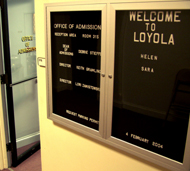Loyola University interim president the Rev. William Byron, S.J., recently brought an unbalanced male-to-female ratio in student admissions to the attention of the university community during his address at the spring convocation.
“It struck me when I returned to Loyola last fall that there is a notable increase of females in the student body,” Byron said.
According to data from the Loyola Office of Institutional Research, in 2001, female enrollment was 63 percent; male enrollment was 37 percent. As indicated by Dean of Admissions Debra Stieffel, in 2002, female students comprised almost 62 percent of the student population, while males represented just 38 percent; for 2003, the ratio was 60 percent to 40 percent.
According to Stieffel, the number of male applicants has risen 10 percent, while female applicants are up by 2 percent.
“You see a higher percent of women who go on to college,” Stieffel said, “and we would like to see more men in our freshmen class.”
Byron said that he’s happy “to see more women moving into higher education, and thus preparing themselves to do well in life in whatever they choose.”
The concern, seems to be whether Loyola is prepared to accommodate larger numbers of women.
“We recruit them, and we welcome them, and we want to serve them as best we can,” Byron said.
Byron said the higher percentages of women have led him to question, “Are there different learning patterns, and how are we adapting to that? Are there different interests that women have that we should be attending to more carefully because we have more women here? Do we have the facilities that the larger number of women need?”
Retention rates are another concern for admininstrators. When asked if he was concerned with the number of students who stay with Loyola to graduation, Byron said that he would only settle for a 100 percent retention rate.
“If they don’t [stay] because we failed them, then I’m not satisfied,” he said.
Stieffel said the university looks into problems that students encounter with the school.
“It’s important to see where our students go, why they leave,” she said.
Comparatively, though, Stieffel said, “We’re above the national average for our graduation rates. At Loyola, that rate has been going up.”
For 2003, minorities made up the highest percentage of students since 1996. Minority applicants are also up: Hispanic, 20 percent, and African American, 15 percent, Stieffel said.
“Last year, 33.3 percent of our applicant pool was minority; this year, 36.4 percent of our applicant pool is minority,” she said. “We do try to identify talented minority students.”
Byron said that retaining minority students is integral to the university mission of social justice.
“We’re here to serve, and we know that there are higher instances of poverty in minority groups,” Byron said. “We know that the best anti-poverty measure you can take is education, and so we would like to educate members of minority groups so that we can help them avoid poverty, or get out of poverty, and they could make a productive contribution to society.”






